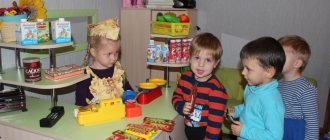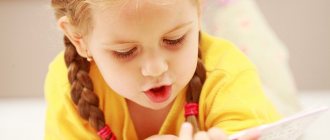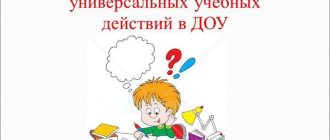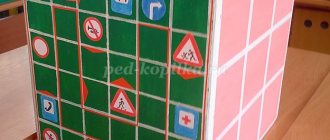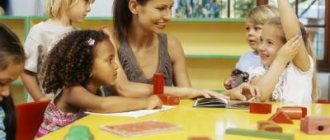Summary of lessons on rhythm for children of senior preschool age.
Summary of a lesson on rhythm in the preparatory group “Multi-colored caps”
Purpose of the lesson:
development of the motor sphere of children, formation of spatial orientation skills, development of imagination and the ability to motor improvisation.
Tasks:
1. Develop spatial orientation skills. 2.Develop attention, memory, creative imagination. 3.Overcome motor automaticity. 4.Develop the visual and motor response of children to light, verbal, visual signals. 5. To foster children’s independence in performing exercises Equipment: tape recorder, piano, audio cassettes with recordings, flashlights, cards with diagrams, sun mat, chest, gnome hats. Children's musical instruments: bells, rattles, bells, maracas
Progress of the lesson:
Children enter the hall to the music and stand in two columns - boys and girls. Greetings and bows. Teacher. Today I invite you to go to a fairy tale. Now you and I will fly to the music. If the music stops, it means there is some kind of obstacle on the way. You will see the diagram and line up the same way.
Exercise on rearranging in space
Children move loosely in accordance with the musical accompaniment (light running, jumping). With the end of the music, they are built in accordance with the diagram (circle, column, 2 circles, 2 columns) Teacher. Guys, look, we are visiting some fairy-tale characters. I will help you. Listen to the riddle. The rainbow has exactly seven colors, And music has seven notes, Well, in this fairy tale there are seven different gnomes. But look, there are no gnomes, only their caps are here. Yes, they are all different colors! Why do you think? (probably because gnomes have different personalities) Oh, and there’s a note here. Reads: “Our caps are magical. If you put the cap on, you can find out who its owner is. Only the one who eats the magic candy can find out what the caps say.” Since there is only one candy, and there are many of us, let Olga Alexandrovna eat it. (the teacher eats the candy and puts on the first cap) Teacher. This cap (red) is worn by the gnome Veselchak. He loves to play fun games. So we're going to play now.
Game "Remember the movement"
Children line up in two lines. The teacher and the children determine what movements they will perform for each count: 1, 2, 3, 4. Then, to the music, they perform the movement at the teacher’s command. In order, in reverse order, out of order. Teacher. Whose cap is next (orange)? Educator. This is the big gnome. He takes great care of his health. How can you monitor your health? Teacher. We will also give you a massage now.
Game self-massage
Children sit on the floor. Yes, yes, yes, yes, rub your hands together. It's getting cold. Yes, yes, yes, yes, they gently stroke the neck from top to bottom with their palms. The water turned to ice. Doo-doo-doo-doo massage the wings of the nose. I slipped on the ice. Doo-doo-doo-doo rub their ears with their palms. I'm going skiing. Dy-dy-dy-dy put your palm to your forehead with a “visor” and move There are footprints in the snow Dy-dy-dy-dy stroke your stomach clockwise Where to find food in the forest Di-di-di-di stroke your feet You walk in the snow . Teacher. It's probably time to find out who's next (green cap)? Educator. This is the gnome Grumpy. He grumbles at the dwarves if they don't come home on time. To call them, he signals with a flashlight. Let's also play with a flashlight.
Game with lanterns
Children move to different types of music, depicting a playful image with their movements (the gnome is cheerful, sad, cheerful). During the music, the flashlight starts flashing. We need to gather around him. Teacher. We put on the next cap (blue). Educator. This is the gnome Dancer. Every evening he gathers the gnomes and learns dances with them. Teacher. Now we will dance too.
"Dance of the Dwarves"
Teacher. Here's the purple cap. Educator. It is worn by the gnome Tanya. He loves to sleep very much, and the other gnomes, so as not to disturb him, try not to make noise. Teacher. Dwarves love to play musical instruments, but at the same time they try not to wake Tanya. We will play a game with you.
“Who will pass the musical instruments more quietly?”
Children line up in two columns, each team has a set of noise instruments: tambourine, maracas, bells, rattle, bell. You need to pass the tools to each other, the latter puts them in a line. Whose team transmits faster and more quietly plays to the music with their own orchestra. Teacher. Now the next cap (blue). Educator. Dwarf Naughty. He loves fun outdoor games! Teacher. I even know what game we can play with you.
Game "Centipede"
Children line up in two columns and perform movements according to the text. A fast centipede rushes along the path in the morning. - While standing, move their hands. She knocks loudly with her feet. She is in a hurry for business. - They stomp with their right foot. She got caught on a stump, shook her hands and raised forty legs. - Raise their hands up. Hee-hee-hee yes ha-ha-ha, po - 3 claps on the right and left. That's nonsense. — Place their hands on the shoulders of the person in front. Then, to the music, they move like a train in any direction. They fall and crumble. When the music ends, they must stand up and quickly find their place. Teacher. All the caps are gone, which means the fairy tale is over. Which gnomes left their caps? (Children list) Don't they remind you of anything? That's right, a rainbow. But it seems to me that some color (yellow) is missing here... Yes, the gnome Baby wears a yellow cap and he always forgets to take it off. But look, instead of a cap, he left us the sun, which will help us return to kindergarten. What is it like? (children's answers: warm, affectionate, gentle, bright) Now lie down with your head in the sun. Imagine that you are his rays. The gentle, kind, gentle warmth of the spring sun spreads throughout your body.
Relaxation to music
Teacher. I ask you to line up to bow. What did you like about the lesson? (Children's answers). Bow. Children leave the hall to the music.
Bibliography:
1. Alyabyeva E. A. Correctional and developmental classes for children of senior preschool age. M., 2002. 2. Burenina A.I. “Rhythmic mosaic” Program on rhythmic plasticity for children of preschool and primary school age - 2nd ed., revised. and additional - St. Petersburg: LOIRO, 2000. 3. Gogoleva M. Yu. collection. “Logoritmics in kindergarten” Publisher: Academy of Development. 2006. 4. Kolodnitsky G. A. Musical games, rhythmic exercises and dances for children. Publisher: Gnom-Press 2007 5. Plaksina L.I. Kindergarten programs. Corrective work in kindergarten. M., “City”, 19 6. Chistyakova M.I. Psycho-gymnastics. M., 1990.
